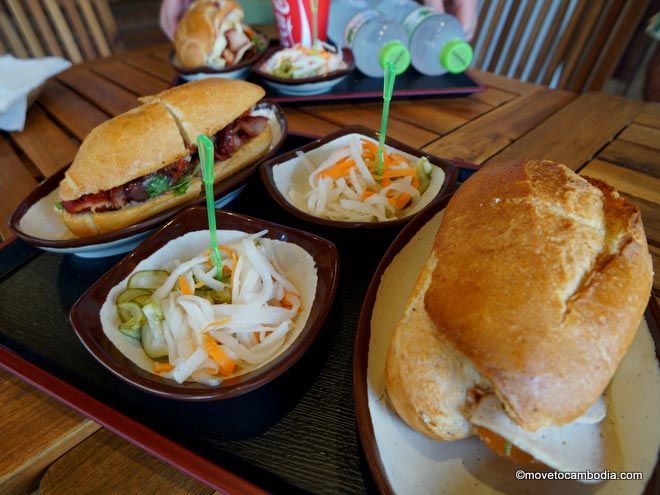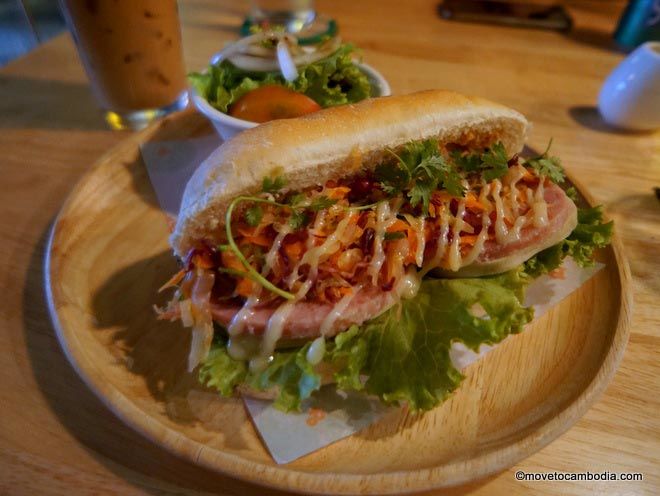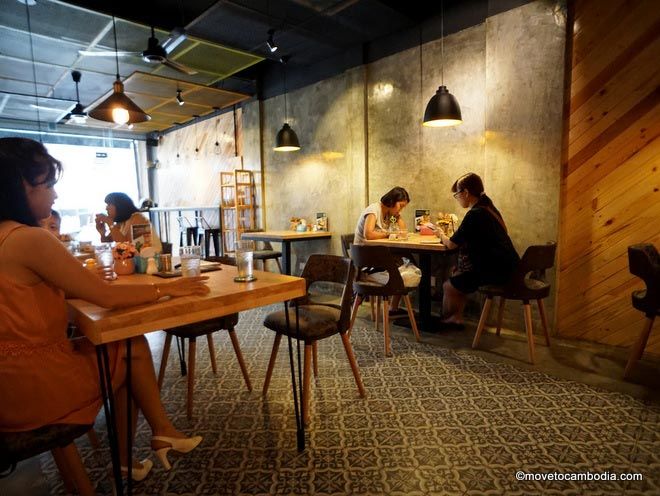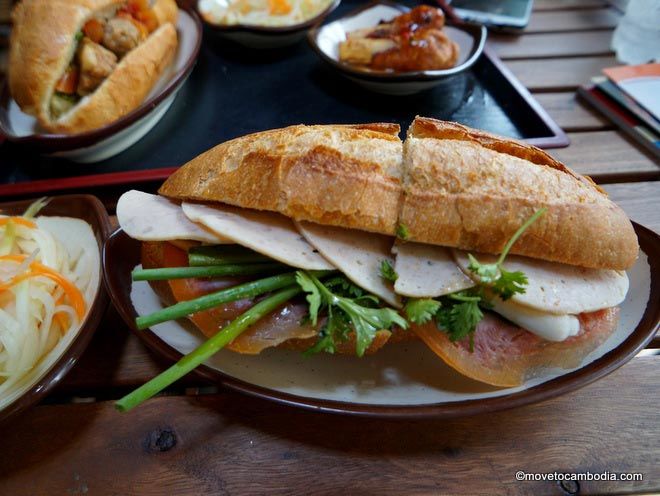Banh mi or num pang? There’s always been a dispute about the humble Vietnamese and Cambodian sandwich. Who invented them? Is there actually a difference between num pang and banh mi? And which is better? While the debate rages, I went to try two new sandwich shops in Phnom Penh, Nömpang and Banh Mi Bros, to see what the fuss is about.

Is it num pang? Is it banh mi? Does it matter?
Banh mi has been all the rage in the Western world for a while now, and now, the Cambodian version of it has even made it big in New York City, where there are now six outlets of the trendy sandwich shop Num Pang. Banh mi is said to have originated in Saigon during the French occupation. The Vietnamese took a simple Parisian-style sandwich and added their own flourishes, including pickled carrots, radish, and cucumber, and fresh herbs. The result is what have many questioning whether banh mi is “the best sandwich in the world.”
It’s believed that the ethnic Vietnamese who lived in Phnom Penh before the war brought the sandwiches with them to Cambodia. “I think [the Vietnamese version] is more balanced, in terms of flavor and texture,” says Vinh Dao, a Vietnamese-American who lived in Phnom Penh for many years and now runs street food tours in Ho Chi Minh City. The usual ingredients for a “classic” banh mi or num pang — often called num pang pâté — are pâté, pork sausage roll, sometimes more pork, pickled carrots and daikon radish, cucumbers either fresh or pickled, cilantro, and sometimes, spring onions, all housed inside a baguette that is soft on the inside, crispy on the outside, and slathered with a generous helping of margarine.

Banh Mi & Bros adds gourmet flourishes to the classic Cambodian sandwich.
So what’s the difference between banh mi and num pang? Not much, but most agree that the typical banh mi is slightly more appealing. What’s the difference between Banh Mi & Bros and Nömpang, two new sandwich shops in Phnom Penh? Not much, but our tasters agreed that Banh Mi & Bros is slightly more delicious.
Banh Mi & Bros was started by a group of French expats inspired by banh mi’s popularity in Paris. With brushed concrete, traditional Cambodian tiles, and a slick-looking bar, the restaurant is a far cry from the usual street stall where the sandwiches are typically sold in Cambodia. They serve eight sandwich variations, priced between $2.80 and $3.80. The ‘Special Brothers’ sandwich is a riff on the classic banh mi, made with Vietnamese pork sausage roll, ham, and pâté.

Dorothy, I don’t think we’re eating street food anymore!
It’s not cheap by banh mi standards, but it’s delicious. More balanced than the ones served off of street carts, the ratio of veggies to meat is higher. Instead of traditional julienned pickled radish and carrots, Bahn Mi & Bros serves a slaw of grated, lightly pickled carrots, cucumber, and cabbage. Touches like homemade mayonnaise and perfectly crunchy (and not sweet!) baguette make clear that this is far too gourmet to be street food.
Nömpang has a more casual offering than Banh Mi & Bros. Opened by a Canadian-Cambodia (the same of the Pop Tea empire), their Russian Market-area cafe has a kitchen that is larger than the actual seating area, and when it gets crowded the service can be a bit chaotic. The place is popular with young Cambodians because the price is right; a classic banh mi is just $1.95. And yes, it is a banh mi. They’ve hedged a bit on the name, calling the cafe Nömpang but advertising their offerings as “the best banh mi in Phnom Penh.”

The classic banh mi at Nömpang, Phnom Penh.
Nömpang’s sandwiches don’t have a lot of gourmet touches — they are essentially the same sandwiches you’ll find being sold out of street carts, only made hygienically and with higher-quality ingredients. Which isn’t a bad thing; num pang are one of the few street foods I avoid because the sight of meat sitting in glass cases in the sun turns my stomach (but I still have them occasionally). Moreover, market forces that require num pang sellers to keep prices as low as possible (2,500 riel, or about $0.60) mean that as the price of ingredients rise, only the very cheapest can be used, leaving room for a more expensive alternative for those who can pay.
Nömpang’s classic banh mi has a light layer of pâté, thin slices of pork sauce roll and ham, spring onions, cilantro, and a side of lightly pickled radish, carrot, and cucumber that you can choose to add to your sandwich. The thin slices of meat make a big difference; the ones on the street have large, crudely cut slices that throw the balance of the sandwich off. My only complaint is that the Nömpang baguettes — while meeting the requirement of crunchy on the outside and soft on the inside — has the typical sweetness found in most Cambodian bread, which detracts from the final product.
Overall? Banh Mi & Bros and Nömpang both have their high points. Banh Mi & Bros offers a more gourmet but non-traditional offering in a stylish environment while Nömpang has a classic banh mi that’s hygienically prepared, inexpensive, and great for meals on the run. Try them both and see what you think!
Banh Mi & Bros
Open daily, 10 a.m. to 10 p.m.
157 Street 63 (just off of Sihanouk Blvd), BKK1, Phnom Penh
T: 085 400 880
facebook.com/banhmiandbros
Nömpang
Open daily, 7 a.m. to 9 p.m.
89 Street 163 (corner of Street 408), Toul Tom Pong, Phnom Penh
(other locations can be found on their website).
T: 081 311 117; 077 563 132
nompangcambodia.com
“The thin slices of meat make a big difference; the ones on the street have large, crudely cut slices that throw the balance of the sandwich off.”
Spot on. Those thick slices of “meat” (pre-Upton Sinclair definition) that street vendors use are one of the reasons I eat fewer ban mi or nom pang style sandwiches in Phnom Penh than I did growing up in San Francisco.
On the other hand, those sandwiches in your pictures look really good, so I’m going to have to put “Banh Mi & Bros” and “Nömpang” on my list of restaurants to visit.
Thanks Lina.
thick slices of “meat” (pre-Upton Sinclair definition)
Ha! Exactly. Report back once you try these places and let me know what you think.